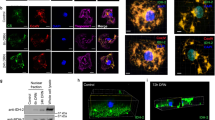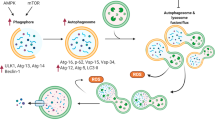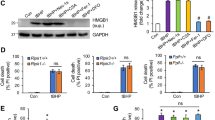Abstract
Doxorubicin is believed to cause dose-dependent cardiotoxicity through redox cycling and the generation of reactive oxygen species (ROS). Here we show that cardiomyocyte-specific deletion of Top2b (encoding topoisomerase-IIβ) protects cardiomyocytes from doxorubicin-induced DNA double-strand breaks and transcriptome changes that are responsible for defective mitochondrial biogenesis and ROS formation. Furthermore, cardiomyocyte-specific deletion of Top2b protects mice from the development of doxorubicin-induced progressive heart failure, suggesting that doxorubicin-induced cardiotoxicity is mediated by topoisomerase-IIβ in cardiomyocytes.
This is a preview of subscription content, access via your institution
Access options
Subscribe to this journal
Receive 12 print issues and online access
$209.00 per year
only $17.42 per issue
Buy this article
- Purchase on Springer Link
- Instant access to full article PDF
Prices may be subject to local taxes which are calculated during checkout


Similar content being viewed by others
Accession codes
References
Yeh, E.T. & Bickford, C.L. J. Am. Coll. Cardiol. 53, 2231–2247 (2009).
Force, T. & Kolaja, K.L. Nat. Rev. Drug Discov. 10, 111–126 (2011).
Tewey, K.M., Rowe, T.C., Yang, L., Halligan, B.D. & Liu, L.F. Science 226, 466–468 (1984).
Capranico, G., Tinelli, S., Austin, C.A., Fisher, M.L. & Zunino, F. Biochim. Biophys. Acta 1132, 43–48 (1992).
Lyu, Y.L. et al. Mol. Cell. Biol. 26, 7929–7941 (2006).
Singal, P.K. & Iliskovic, N. N. Engl. J. Med. 339, 900–905 (1998).
Myers, C. et al. Semin. Oncol. 10, 53–55 (1983).
Martin, E. et al. Toxicology 255, 72–79 (2009).
Lyu, Y.L. et al. Cancer Res. 67, 8839–8846 (2007).
Lyu, Y.L. & Wang, J.C. Proc. Natl. Acad. Sci. USA 100, 7123–7128 (2003).
Sohal, D.S. et al. Circ. Res. 89, 20–25 (2001).
Okamura, S. et al. Mol. Cell 8, 85–94 (2001).
Ogasawara, J. et al. Nature 364, 806–809 (1993).
Plesca, D., Mazumder, S. & Almasan, A. Methods Enzymol. 446, 107–122 (2008).
Arany, Z. et al. Proc. Natl. Acad. Sci. USA 103, 10086–10091 (2006).
Lai, L. et al. Genes Dev. 22, 1948–1961 (2008).
Wang, J. et al. Circ. Res. 106, 1904–1911 (2010).
Wallace, K.B. Pharmacol. Toxicol. 93, 105–115 (2003).
Sahin, E. et al. Nature 470, 359–365 (2011).
Ju, B.G. et al. Science 312, 1798–1802 (2006).
Liao, R. & Jain, M. Methods Mol. Med. 139, 251–262 (2007).
Bawa-Khalfe, T., Cheng, J., Wang, Z. & Yeh, E.T. J. Biol. Chem. 282, 37341–37349 (2007).
Ishii, K.A. et al. Nat. Med. 15, 259–266 (2009).
Zeisberg, E.M. et al. Nat. Med. 13, 952–961 (2007).
Acknowledgements
We thank C.H. Ren for expert technical assistance and F.M. Lin and H. Dou for conducting studies on mitochondria DNA. W.C. Claycomb (Louisiana State University Health Science Center) provided HL-1 cells. This study is supported by the Cancer Prevention Research Institute of Texas and McNair Medical Institute (E.T.H.Y.), US National Institutes of Health grant CA102463 (to L.F.L.), the New Jersey Commission on Cancer Research Grant 06-2419-CCR-EO, US Department of Defense Idea Award W81XWH-07-1-0407 and Concept Award W81XWH06-1-0514 (to Y.L.L.).
Author information
Authors and Affiliations
Contributions
E.T.H.Y. and L.F.L. conceived the project. S.Z., X.L., T.B.-K., L.-S.L. and Y.L.L. performed experiments and data analysis. E.T.H.Y. and S.Z. wrote the manuscript with editorial input from L.F.L. and Y.L.L.
Corresponding author
Ethics declarations
Competing interests
The authors declare no competing financial interests.
Supplementary information
Supplementary Text and Figures
Supplementary Figures 1–5 and Supplementary Tables 1 and 2 (PDF 896 kb)
Rights and permissions
About this article
Cite this article
Zhang, S., Liu, X., Bawa-Khalfe, T. et al. Identification of the molecular basis of doxorubicin-induced cardiotoxicity. Nat Med 18, 1639–1642 (2012). https://doi.org/10.1038/nm.2919
Received:
Accepted:
Published:
Issue Date:
DOI: https://doi.org/10.1038/nm.2919
This article is cited by
-
Biosafe cerium oxide nanozymes protect human pluripotent stem cells and cardiomyocytes from oxidative stress
Journal of Nanobiotechnology (2024)
-
A review of the pathophysiological mechanisms of doxorubicin-induced cardiotoxicity and aging
npj Aging (2024)
-
An all-in-one tetrazine reagent for cysteine-selective labeling and bioorthogonal activable prodrug construction
Nature Communications (2024)
-
Graphene-integrated mesh electronics with converged multifunctionality for tracking multimodal excitation-contraction dynamics in cardiac microtissues
Nature Communications (2024)
-
3-Indolepropionic acid mitigates sub-acute toxicity in the cardiomyocytes of epirubicin-treated female rats
Naunyn-Schmiedeberg's Archives of Pharmacology (2024)



